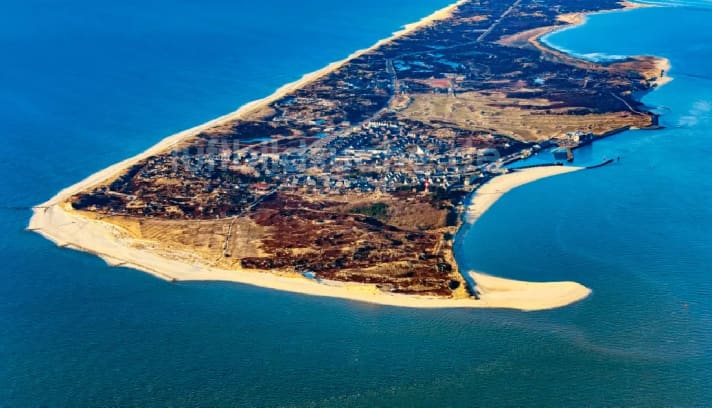North Friesland: In the lee of the North Sea islands of Amrum, Föhr and Sylt
Kristina Müller
· 11.11.2022
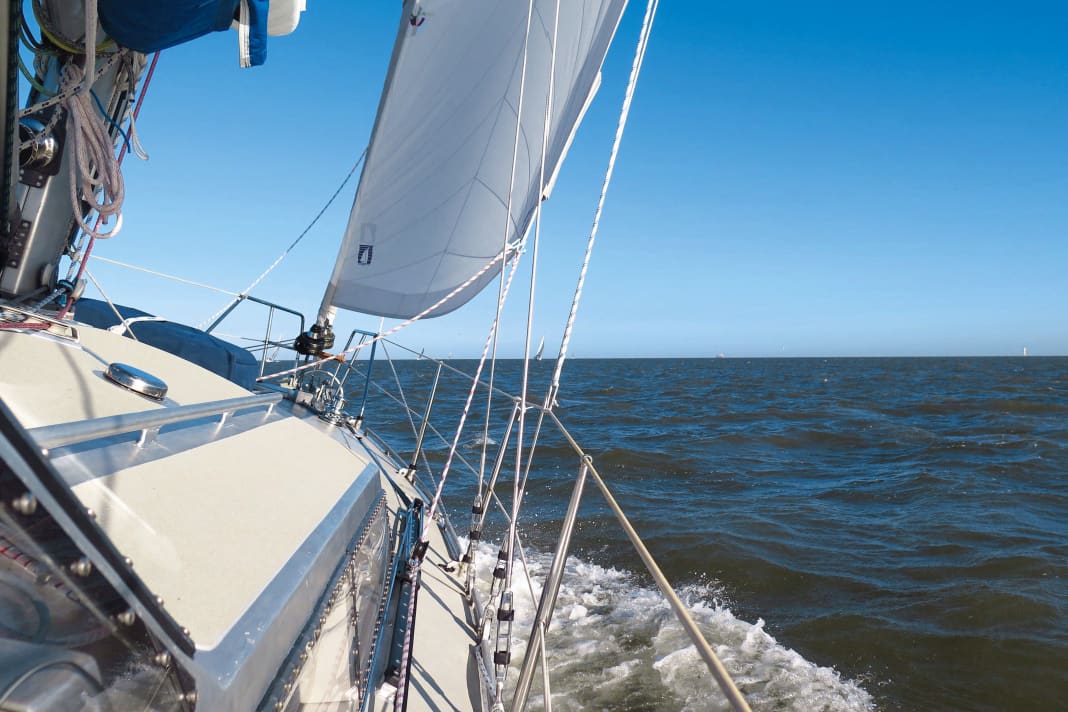





What a miserable rocking! And it gets worse and worse the closer we get to the harbour. So far it has been an exhilarating ride from Bremerhaven out to Helgoland, with half wind and sun, eight knots on the log and broad grins on our faces. But now we have to pay for the sailing fun: The wind dies a few miles from the harbour entrance, leaving only uncomfortable waves from the northwest in its wake.
Once inside, the harbour piers provide immediate shelter. We pack up the sails, and a few minutes later our Reinke is part of a seven-pack. Welcome to Heligoland in summer!
Actually, the island programme would now be on the agenda: watching the sunset at Lange Anna, listening to the screeching of the guillemots, sinking into the "Bunte Kuh". What actually happened: Bunk at eight and comatose holiday kick-off sleep. We had packed the boat until late the night before, after last winter's refit had somehow dragged on into the summer. We are therefore eager to get sailing and want to make long trips on the North Sea, preferably as far as the Limfjord. But a look at the weather forecast calls for a plan B. It's made quickly and is a good one: Island hopping in North Friesland seems to be the better choice than heading north at will on the unprotected Danish west coast when the north-westerly chill lasts for days.
From Heligoland to Amrum
The next morning, the wave is gone and the 37 nautical miles from Helgoland to Amrum whet our appetite for more and more sea. They are over far too quickly. Reaching North Friesland through the Rütergat feels like sailing through a gateway to another world: The mounds of Hallig Hooge appear dimly to starboard, with the island barely visible beneath them. To port, the long white knee sand of Amrum.
No matter who you ask, everyone raves about the island. So beautiful! So green! You have to go there! So we hoist the sails just before the ferry dock and motor the last mile along Pricken to the harbour. Contrary to all expectations, there is almost nothing going on, and this is at the beginning of July. The season doesn't seem to have really got going yet - it may be due to the weather. Over the next few days, we'll be reaching for a fleece jacket and hot water bottle again and again instead of flip-flops and swimming shorts.
Everything, but also everything on Amrum is well signposted, looks picobello, inviting and touristy. However, we delve deeper into island life - how could it be otherwise when sailing - because of a problem: The bottom bracket of one of our folding bikes gave up the ghost on the very first day. As there are nine bike shops spread across the five island towns, we are in good spirits and start the hunt for spare parts. At attempt number five in Norddorf, we find what we are looking for. The nice blond man who runs the shop not only manages to swap the apparently rare bearing, but also provides us with all sorts of stories and information about his homeland.
As the north-westerly wind has long since set in, we stay a few days to get to know the really pretty Amrum.
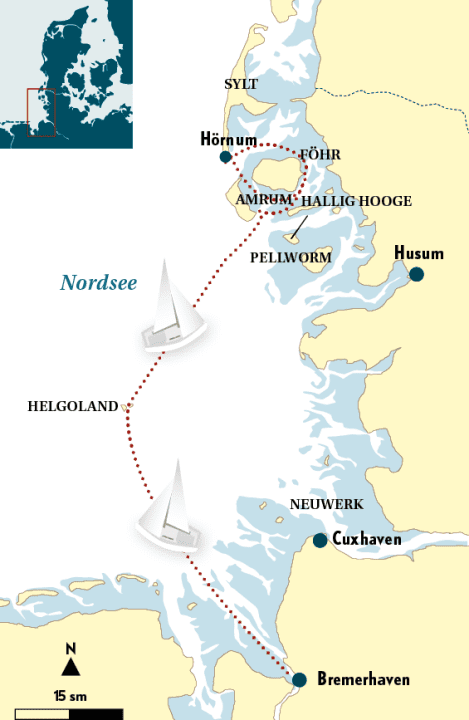
We hike around the northern and southern tips, cycle through pine forests and fields that slope gently down to the Wadden Sea like on no other North Sea island, bake bread and pizza on board - and then make a rookie mistake: picnicking on the windward side of the island means having lunch with sandy breadcrumbs. Still marvellous!
From Amrum to Föhr
The wind doesn't let up and drives us onwards to Föhr in a short, fast rush of almost ten nautical miles. The fairway there is wide, deep and busy with ferries travelling between Föhr and Amrum. Once again, we realise what a privilege it is as sailors to be able to decide spontaneously which island we want to visit next and discover several in one trip. Without a fixed timetable and expensive tickets.
Even on Föhr, the largest German island without a fixed connection to land, there is only one marina. It is sheltered off Wyk, the island's "town", and almost always has enough water even for deeper boats. There are also more free berths here than expected. Many crews are obviously either in the Baltic Sea or on the mainland due to the bad weather.
Its tourism experts advertise the island as the "Frisian Caribbean" and indeed: in the lee of the terraces of the cafés on the beach promenade, with a view of glittering water and powdery sand, the comparison is only a little more apt. Pulling out Plan B and having plenty of time to discover North Friesland just feels perfect. This obviously encourages overconfidence: you can cover a good 40 kilometres on a cycle tour around the island. An easy task for all those who are battling the Nordwester on e-bikes. On 14-inch bikes, on the other hand, the thought of the next bus briefly comes to mind.
What a privilege it is as a sailor to be able to decide spontaneously which island you want to visit next!"
The next day there's a knock on the side of the boat. A friend of a friend is standing on the jetty and wants to know if we have everything we need. Everyone here is friendly, without question. We quickly get chatting about the area and the destinations we still have to discover. Do we already know Oland, the small island that is only connected to Langeneß by a causeway and where hardly any boats go apart from a passenger ferry? Unfortunately not! But we would change our plans for such a lonely Hallig adventure.
But we postpone Oland until another time and stick with the idea of sailing on from Föhr to Sylt. With a constant westerly wind forecast, it would be like being trapped in a mousetrap on the Hallig.
From Föhr to Sylt
There are three routes for the trip to Hörnum: via the mudflat fairway north-east past Föhr or along the mudflat fairway between Amrum and Föhr. Or "round the outside": This would mean sailing through the Rütergat out into the North Sea and back in through the Vortrapptief.
As the wind and tide harmonise best for this, option number two is chosen. After all, we were sailing a chine keeler with a draught of just 1.10 metres that was suitable for the tidal flats, and the Prickenweg looked temptingly beautiful from Amrumer Strand. Crossing the ebb current to Wittdün requires attention between all the ferries, fishermen and a few yachts. Then the anchor drops in the shelter of Amrum, only to continue sailing across the mudflats as the water rises.
There, too, it is obvious how quiet the area is. Not one other sailing crew is travelling between Föhr and Amrum. The Wadden Sea seems to belong to us - and to a working ship that unexpectedly gives us an adrenaline rush: halfway along the route, the buoys end, but a thick, long pipe for flushing work hangs from the barge into the water, which we have to cross. Late on, we discover the few spare buoys and sail on more slowly, close to the workboat. Its crew lean relaxed against the railing, greeting us and oblivious to our excitement.
We are greeted by the harbour master in Hörnum with an unmistakable "Over here!" through the megaphone and directed to a berth. Not far from the modern harbour, surfing students are practising staying on their boards on the beach, dinghy sailors are chasing buoys and we are shivering and dipping our toes in the water. Definitely too cold for swimming! Then it's time to get on our bikes - the marathon distance from Föhr has long been forgotten.
There is still time, but as the return journey takes us back across the German Bight, we start to listen carefully to the trends in the weather forecast. As before: West-north-west and more of it rather than less. That means uncomfortable sea conditions and lots of waves outside - so we prefer to stay in the shelter of the islands. The northern mudflat fairway to Föhr via the so-called Föhrer Schulter still appeals to us. With the tidal current and wind from astern, the second leg to Wyk promises to be brisk - and would complete the round trip around Föhr under sail.
We're making a rookie mistake: picnic on the beach means lunch snack with sand breading. But it's still marvellous!"
First we follow the string of green buoys. Our six-and-a-half tonne steamer runs as if on rails across the grey sea. In fact, the closer we get to the mainland, the sailing here reminds me of sailing on the Dutch lakes: shallow water, short waves, the shore never too far away. The only difference is that the plug isn't pulled every twelve hours. After four hours of hooking along tidal flats on the mudflats, we finish our tour in front of Wyk harbour. Once inside, the wind picks up again.
An engine chugs, it's just before four in the morning. The noise gets louder and closer. I jump out of my bunk. Someone is actually coming in on this uncomfortable night and wants to moor next to us. The skipper needs several attempts. No wonder, given the wind and what he and his co-sailor have obviously just experienced. The lines are not yet fully tightened when they tell us that they rammed one of the fairway buoys in the Rütergat at full speed and were lucky that their Bavaria is still afloat. And indeed, the next morning they notice the bent bowsprit and other collision damage. They were lucky in their misfortune - and are a reminder for us of how important it is never to be reckless in this challenging area with strong tidal currents and shallows.
We have long since renamed the weather app the "bad mood app". Of course, now that we have to sail back, the wind is supposed to die down and turn to the south. It just never fits. We briefly consider alternatives. Return via Neuwerk instead of Helgoland? Or go through in one go? Neither is any better.
Finally, we cross to Amrum and wait for the next high tide. Then the ebb current and engine push us out into the North Sea in the first morning light. This time Amrum remains to starboard and Hooge to port. We really want to go there again and then discover tiny Halligen instead of vast islands. It almost sounds like a perfect next plan B.
Amrum - Harbour info & tips
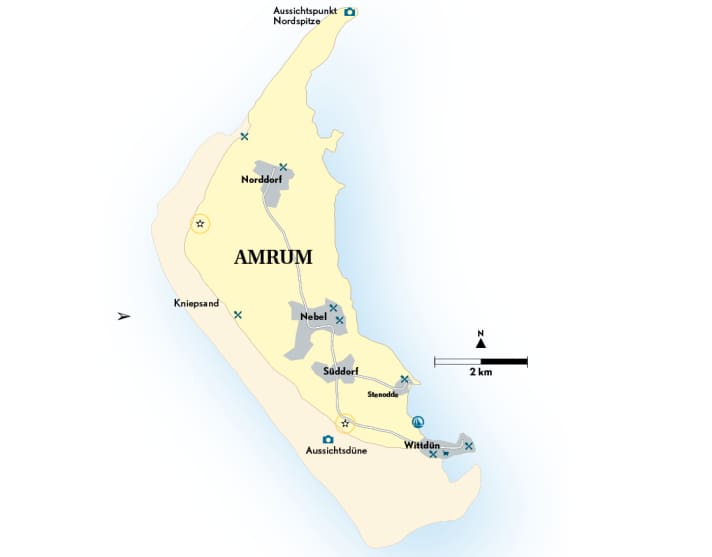
Due to its location, Wittdün is the first stop for many crews coming from the south on their North Friesland trip. Guests moor alongside on the northern of the two jetties. If the harbour is full, they can also moor in the packet. The harbour is deepest here and the berths on the southern jetty are dry.
The mooring prices in 2022 were 1.80 euros per metre of boat length plus visitor's tax (2.60 euros per person per day) and electricity (3 euros/day). Sanitary facilities can be found in the clubhouse next to the restaurant. www.a-y-c.de
Highlight
A walk around the northern tip is particularly beautiful. There you can see Föhr and Sylt. There are dunes, beaches and mudflats along the way
Eye-catcher
The Frisian village of Nebel looks like something out of a picture book. Thatched-roof houses, cottage gardens and parlours are lined up one after the other
Hotspot
Wittdün has everything: supermarkets, shops, hire bikes, bakers. The walk from the harbour along the water takes 15 minutes
Föhr - Harbour info & tips
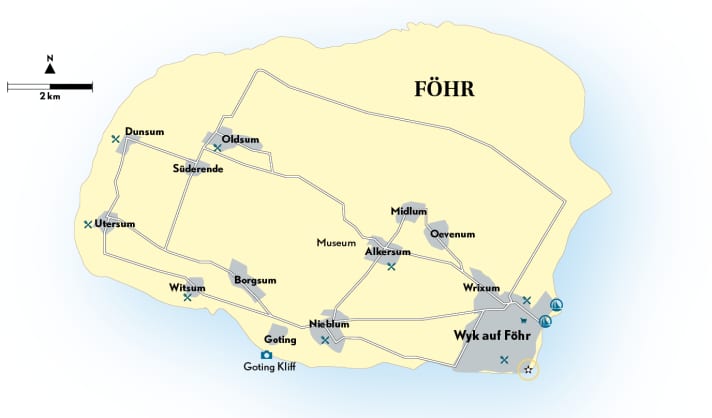
As a visitor, you have a choice: either turn off to starboard behind the harbour entrance and moor at the rearmost jetty or in a free box on one of the floating jetties. The harbour does not dry out and the sanitary facilities at the Föhr Sports Boat Club are new and almost luxurious. The mooring fee is two euros per metre of boat length. Alternatively, you can head to port in the old harbour. Here, boats are moored directly on the market square in the hustle and bustle, but at low tide they are also moored far down in front of high quay walls and close to the road. Several ferries constantly dock and depart in front of the harbour entrance, so you have to watch out for them. www.wyk.de/hafen
Highlight
A boardwalk with benches leads along the beach at Nieblum: a great place to read and daydream
Eye-catcher
The Museum of the West Coast in Alkersum presents international modern art from the 19th to 21st centuries on the theme of "Sea and Coast"
Hotspot
Wyk on Föhr is the starting point for all island tours and ideal for sailors to provision and go out
Sylt - Harbour info & tips
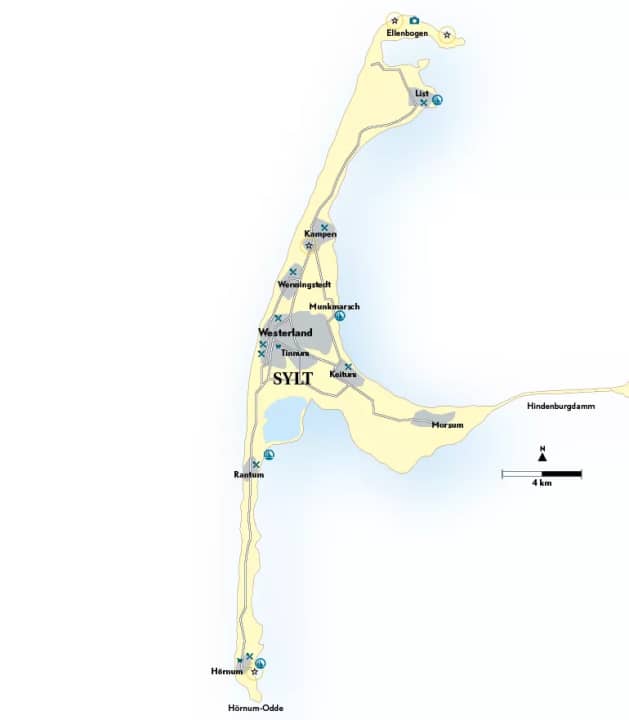
The largest and best marina is Hörnum, even if it is rather busy because of the ferries and mussel fishermen that come and go day and night. When he is on site, the harbour master calls out the number of a free berth to arriving crews and sometimes helps with mooring. Very good sanitary facilities in the Sylt Yacht Club building. This is also where you pay the mooring fee; most recently 23 euros for boats up to eleven metres including electricity. www.sylter-yachtclub.de
Highlight
No matter where, the beach is never far away on Sylt. A hike along the "Ellenbogen" in the north of the island is also particularly beautiful
Hotspot
If you want to do some shopping and go out, take the bus to the centre of Westerland. There is a small supermarket in Hörnum
Victims of the storm surges
On the North and East Frisian Islands, the sea conquers the land during storms. After storm surges, large parts of the beach are often missing and can only be washed up with difficulty. On Sylt, Hörnum-Odde is particularly affected (photo)
